Table of Content
- What are spider flies?
- Deadly spider patterns
- Tying North Country Spiders
- Spider fishing tackle
- Where to fish spiders
- Spider fishing techniques
- Upstream spider fishing
Fly fishing for trout and grayling with North Country Spiders has a special place in my heart because it was the start of my fly tying and fly fishing journey.
The Partridge and Orange was the first fly pattern I tied in my school’s fly tying club. Using this fly, I caught my first wild brown trout above Stainforth Force on the River Ribble in the Yorkshire Dales.
Nearly 50 years on, I’ve tied hundreds of spiders and caught hundreds of trout and grayling on North Country Spider flies.
What are spider flies?
North Country Spiders (sometimes called soft hackle flies) have been catching trout for well over 200 years and more recently grayling.
Originally, the flies were designed for fishing the fast-flowing rivers of northern England for trout. However, today, you wouldn’t be out of place fishing spiders on freestone rivers, chalk streams, lakes, or lochs.

Contrary to what their name suggests, these flies are designed to imitate aquatic insects and not spiders. Some fly patterns were designed to imitate specific flies, but more often than not, they just represent a general impression of emerging, stillborn or drowned flies.
In essence, spiders are a subcategory of wet flies consisting of little more than a thread body and a sparse mobile soft feather hackle (1 to 2 turns).
Spider patterns are effective at catching fish because the soft hackle produces a life-like movement when buffeted by moving water, thus imitating the slender-bodied emerging flies and nymphs.
If you’re beginning a fly tying and fishing journey there are a couple of reasons to recommend spider flies:
- They are simple to tie, and
- Are effective initiations of many flies.
So, what spider patterns do I regularly fish….
Deadly spider fly patterns to try:
You could fill several fly boxes tying the seemingly endless variety of North Country Spiders. To the beginner, the bewildering variety of spider fly patterns can make it difficult to decide which patterns to choose.
Therefore, I’ve pulled out the North Country flies that, over the years, have become…
my ‘workhorse’ spider flies…
That imitates most insects I’m likely to encounter on the river throughout the year.
First up, is the…
March Brown Spider
Without a doubt, the March Brown Spider is…
Top of my spider pattern list…
Because on the rivers I fish, it consistently catches trout and grayling throughout the year. Also, during the sea trout season on the Welsh Dee, it’s good daytime sea trout fly.
I believe its all-around success comes from it being a good general imitation of a variety of hatching olive nymphs.
For me, not having any March Brown Spiders in my fly box is akin to…
forgetting my fly rod!
Well, maybe not quite that bad but it’s up there!
My fly box always contains two March Brown Spider patterns. First the…
Gold-ribbed March Brown Spider pattern:

- Hook: Kamasan B170 #14 & 16
- Thread: Waxed orange UNI 8/0
- Body: Hare’s ears dubbing
- Rib: Medium gold wire
- Hackle: Brown partridge neck feather
This pattern is best fished early and late in the season, particularly when trout and grayling are feeding on ascending olive nymphs.
Second up, is the…
Pearl-ribbed March Brown Spider pattern:
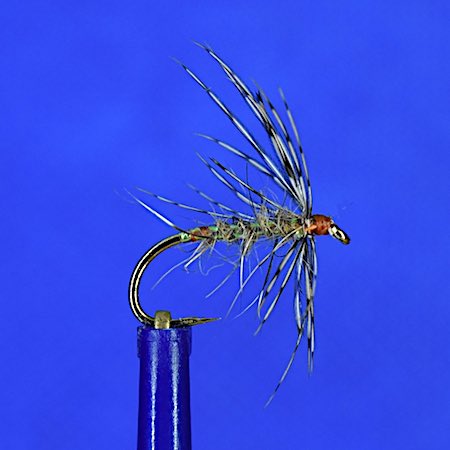
- Hook: Kamasan B170 #14 & 16
- Thread: Waxed orange UNI 8/0
- Body: Hare’s ears dubbing
- Rib: Pearl Mylar fine
- Hackle: Brown partridge neck feather
This pattern comes into its own as the weather warms and when trout and grayling are focused on taking emerging flies.
Next on the list is a…
Black Spider Patterns:

- Hook: HENDS B354 #18 & 16
- Thread: Black UNI-Thread 8/0
- Rib: Uni Pearl Mylar (1/32)
- Hackle: Natural black hen
A black spider pattern is another classic and simple fly that will always have a place in my fly box. Despite its drab appearance, it’s a versatile fly that can be counted on to catch trout and grayling throughout the year.
I also fish a variant of black magic spider containing hopper legs, which is deadly when fished wet on the middle dropper or the point.
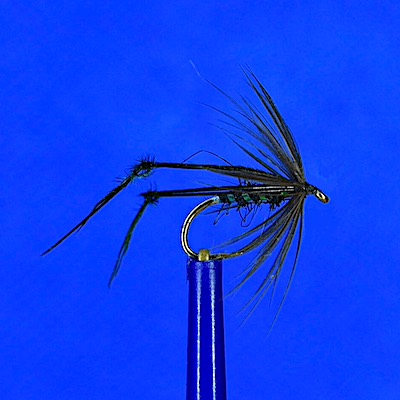
- Hook: Kamasan B170 size 14
- Thread: Black UNI-Thread 8/0
- Body: Black seal fur substitute
- Rib: Uni Pearl Mylar (1/32)
- Legs: Black pheasant tail
- Hackle: Natural black hen
Like the March Brown spider, both these black flies will catch sea trout during the day.
Waterhen Bloa Spider (pearl butt) fly pattern:
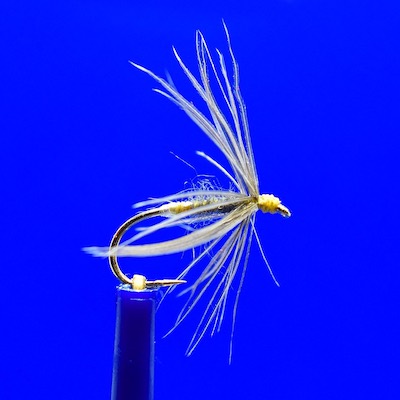
- Hook: Kamasan B170 #14 &16
- Thread: Primrose silk
- Tag: Pearl Mylar (1/32)
- Body: Finely dubbed Mole fur
- Hackle: Waterhen undercover wing
In the surface layers of the river, this straggly-bodied soft hackle fly is a great imitation of a member of the olive family struggling to break free from the surface and hatch.
It usually performs best on the Welsh dee from March to May but will catch fish when olives are hatching throughout the season.
Partridge and Orange spider pattern
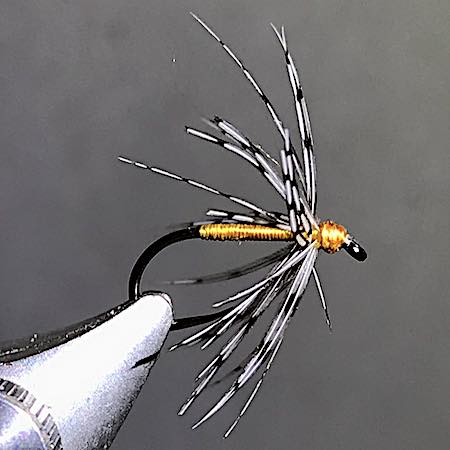
- Hook: HENDS B354 #14 &16
- Thread: Waxed Gossamer orange silk
- Hackle: Grey Pheasant neck feather
The Partridge & Orange is one of the best known of all the spider fly patterns that will catch both trout and grayling.
Considered to be an imitation for small stonefly nymphs, it catches trout from March onwards and grayling through the winter months. I prefer to dead drift this spider it in the surface film
Snipe and Purple spider pattern:

- Hook: Kamasan B170 #14,16 & 18
- Thread: Purple Gossamer silk
- Hackle: Snipe marginal covert feather
The Snipe & Purple is another classic spider pattern for trout and grayling fishing, which is a good imitation of Iron Blue nymph and emerging duns. Fished from May through to Autumn.
Black and Peacock spider pattern:

- Hook: HENDS B354 #14 &16
- Thread: Black Uni 8/0
- Body: Peacock herl
- Rib: Fine gold wire
- Hackle: Natural black cock
The black and peacock spider is a simple fly to tie and it’s worth having a few in your fly box. For me, it comes into its own when there is a lack of fly life on the river and has caught some lovely trout and grayling over the years on the River Ribble and Welsh Dee.
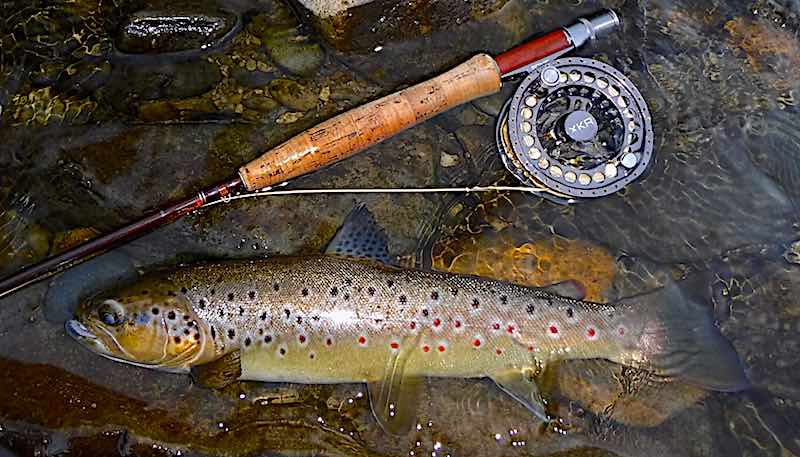
Modern ‘Bling’ Spider flies
In recent years the development of a whole host of new fly tying materials has stimulated the imagination of fly fishers to design and test many new soft hackle flies.
A couple of years ago I came across an interesting fishing article “Sewin in the Sunshine” by Neil Darling (Flyfishing and Flytying magazine March 2018 ed.), which describes a series of soft hackle flies ‘Bling Spiders’. In addition to sea trout, grayling and trout found these Bling spiders irresistible.

I have tied and fished a few of these patterns on the Welsh Dee and River Ribble, where they have caught me grayling, trout, and sea trout when traditional flies have failed. Below are three patterns that are now permanently in my fly box.

Black & Purple Grouse Spider
- Hook – Kamasan B170 # 12 & 10
- Thread – fluoro-orange
- Body – holographic black tinsel
- Rib – fine silver wire
- Thorax – purple Hends Spectra dubbing code 411
- Hackle – Grouse neck
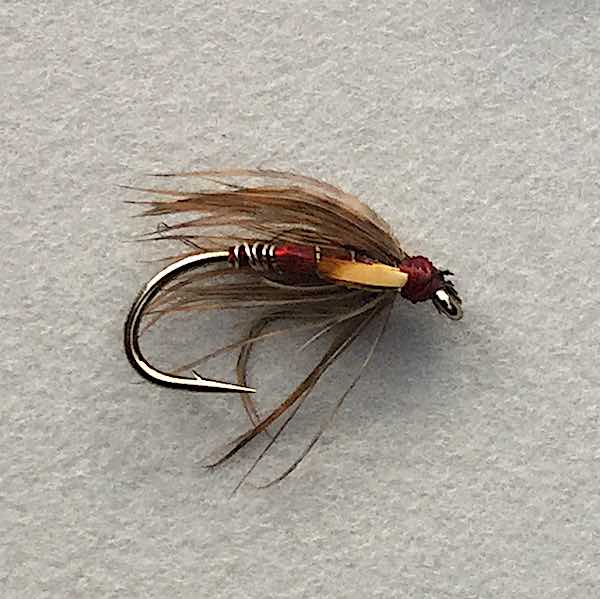
Red Bling Spider
- Hook – Kamasan B170 size 12 & 10
- Thread – red UNI 8/0
- Body – holographic red
- Rib – fine silver wire
- Hackle – Grouse neck
- Cheeks – split jungle cock

Grouse & Olive Bling Spider
- Hook – Kamasan B170 size 12 & 10
- Thread – fluoro-green
- Body – holographic chartreuse
- Thorax – green Hends Spectra dubbing code 89
- Hackle – Grouse neck
Tips for tying North Country spider patterns
Hooks – standard, lightweight fly hooks (e.g. #16 & #14 Kamasan B170 or Fulling Mill All-Purpose 31550) are OK for tying spider flies on. However, it’s better to use a classic spider hook (e.g. #16 & #14 Partridge spider hook L3AS).
In the summer, on heavily fished rivers I had more success fishing spiders tied on fine wire hooks (e.g. #18 VARIVAS 2200BL).
Tying thread – if you can find it, Pearsall’s Gossamer Silk thread is the way to go. However, any reasonable quality fly tying thread will be fine (e.g. Semperfli – Pure Silk, Uni-Thread 8/0)
Hackle feathers – when starting small packs of loose feathers (i.e. hen, partridge, grouse) will allow you to tie plenty of spider flies. To continue your fly tying journey, you will need to add snipe, starling, and woodcock wings to your list of hackle material.
The secret to tying effective spider patterns is to avoid overdressing the fly and keep them simple, slim, and mobile.
Less is MORE with tying spiders.
Especially the hackles, which need to be sparse i.e. 1 to 2 turns of a good quality soft hackle.
Tie your hackle feather so that the fibres splay out like the spokes of an umbrella. This will enable the fly to catch even gentle currents and add essential life-like movement to the fly when fished.
Body dubbing – keep it sparse to maintain a slim spider fly profile. I prefer to use fine natural fur dubbings (e.g. mole, fox ear, hare’s mask). However, fine synthetic dubbing is also great (e.g. Partridge SLF standard dubbing) for tying spiders.
Fly fishing equipment for spider fishing:
Spider fishing rod:
I use a 9ft #5 weight rod with a medium action for all my spider fishing, on small to large rivers. However, I would quite happily use fly rods in the range of 8 to 10 ft and weights from #3 to #5.
Avoid tip or fast action rods because often you will have to present a short line and it’s easier to do this with a medium or softer action rod.
Spider fishing Reel:
For spider fishing, I would recommend a small, lightweight reel matched to the fly line weight. There are plenty of reasonably priced reels on the market that will do. Look for one that has a smooth easy to adjust drag-system.
Fly line for spider fishing:
At the moment, I’m using an Airflo SuperDri WF5 as my spider fishing line. However, most branded lines are of good quality, therefore, if you are starting pick an inexpensive one. Ideally, choose one with a long front taper because this will aid delicate fly presentation.
Leader & Tippet Set-up for spider fishing:
For my standard three spider fly cast, I use a 9ft monofilament knotless tapered leader (e.g. 9ft Leeda Profil 5X – 3lbs) that I cut down to 5ft at the butt (thick end). Then using a 3lb tippet (Maxima Ultragreen) I add two droppers (6” long) spaced 3ft apart.
For a two-fly cast, I just cut the leader down to 7ft, and when using a single spider fly I use the 9ft as is.
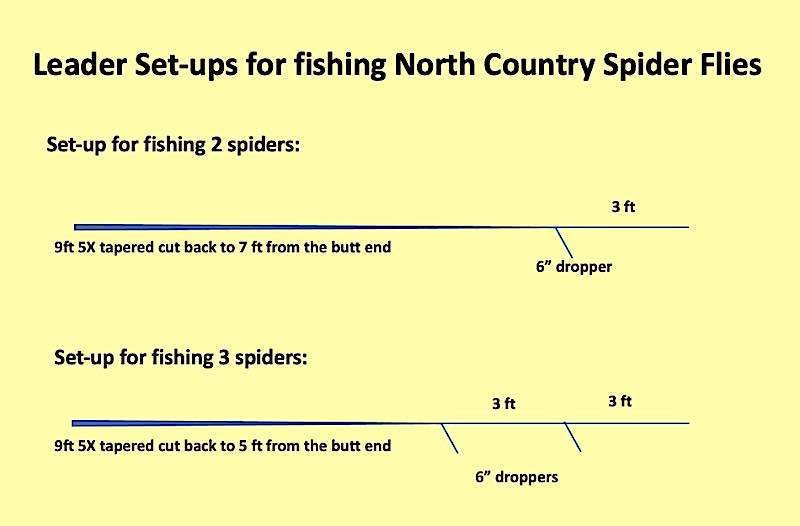
In all cases, the leader should be degreased with Fullers Earth to help it sink. If the spiders are fishing too deep, I add Mucilin grease to the butt section of the tapered leader, which keeps the spiders closer to the surface film.
Where are North Country spiders fished?
North Country Spiders were designed for fishing the fast-flowing rivers of northern England for trout. Today, however, you will find anglers fishing spiders on freestone rivers, chalk streams, lakes, or lochs across the world.
Spider fishing is a technique ideally suited to fishing the riffles and runs of rivers and streams. In these places, there is sufficient current to impart movement into these soft-hackle flies and thus imitate accending nymphs and emergers struggling to break free of the surface film.
On the Welsh Dee at Llangollen, a few good places to practice spider fly fishing include:
So, how to fish North Country spiders…
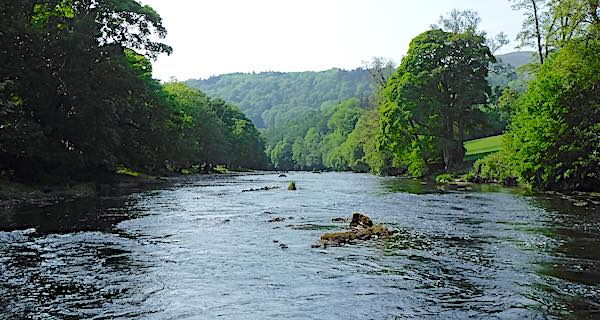
How to fish spider flies for trout and grayling:
Spider fishing techniques
If you are a beginner, the easiest way to fish a team of spiders is to use the ‘Across and Down’ method.
‘Across and Down’ Spider fishing tips:
- At the head of the water you plan to fish, take a position facing downstream at 45 degrees.
- Cast across the flow and let the flow swing your flies down and around.
- Ensure your rod is not parallel with the water but held up at an angle (c.a. 30 degrees). This produces an arc of slacker line which absorbs the impact of the take and thus more hook-ups.
- Let the flies dangle at the end of the swing for a few seconds.
- Then slowly lift the rod tip to move the flies upriver, which can produce an induced take.
- If you feel a take, a simple lift of the rod to keep in contact with the fish.
- Take a step downriver and repeat the process until you reach the end of the run.
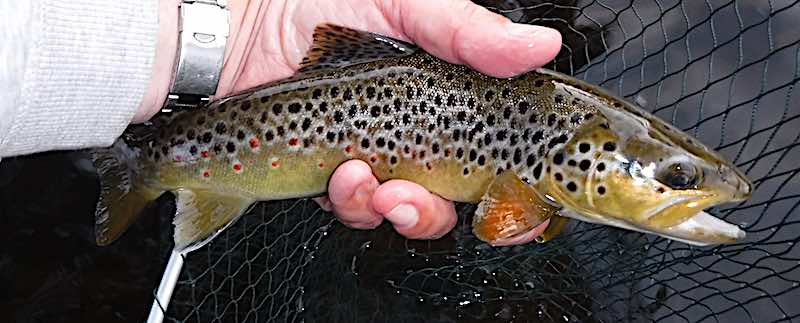
The advantage of the above method is that it’s easy for beginners but it does have some disadvantages:
- The spiders don’t move naturally downriver but swing around in the current. Therefore, you are likely to catch the smaller unwise fish.
- Your upstream position is likely to spook large fish.
- Fish tend to pluck at the fly, which results in missed takes.
Therefore, once the simple ‘across and down’ technique is mastered, you should progress to the more advanced methods.
To significantly improve your chances of catching larger fish with the ‘Across and Down” approach you need to modify it with…
The Reach Cast:
The purpose of the Reach Cast is to lay the fly line on the water in a way that allows the flies to dead-drift downriver.
The Reach Cast is a modified overhead cast where before the line lands on the water you move the rod upstream and allow the line to run through the rings, so the flies don’t jerk back.
At the end of the cast, the rod tip is pointing upstream. From that position, you move the rod-tip downriver at the same speed as the current to dead-drift the spider over the fish.
The following video is a good demonstration of the Reach Cast:
Upstream spider fishing:
Fishing spiders upstream, as you would a nymph, is very effective but also the most challenging method.
Select a fish-holding spot, cast a straight short line (10 to 15ft) into it, and raise your rod tip to pick up the slack line off the water as the spiders drift towards you. The take that might be a boil as the fish takes the spider just under the surface or the fly line might stop or dart upstream.
A brightly coloured braided loop helps you quickly pick out the end of the fly line and detect takes.
Upstream spider fishing is challenging because of the short drifts and the many casts required to cover all potential fish-holding spots, as you fish upriver. However, once mastered the rewards are well worth it.
The following video features Oliver Edwards demonstrating the art of upstream wet / spider fishing.
If you are interested in practising fly fishing spider flies for trout and grayling on the Welsh Dee there is some excellent Day Ticket water available.
Further reading on North Country Spiders
If you are interested in learning more about North Country Spiders there are two books I would recommend reading.
- The North Country Fly: Yorkshire’s Soft Hackle Tradition by Robert L. Smith.
- A Guide to North Country Flies and How To Tie Them: 140 Flies with Step-by-Step Photographs by Mike Harding.
Finally, I hope you have enjoyed this article on how to tie and fish spider flies and it has stimulated you to go spider fishing on your local rivers.
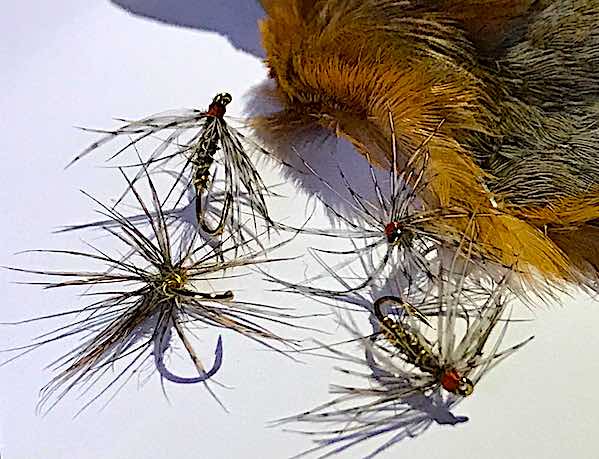
great website / blog – well laid out and interesting comment.
Would like to understand the difference between Euro and Czech nymphing.
Hi Steve,
Euro Nymphing is a collaboration of various different nymphing techniques all rolled into one. I look at it as a hybrid of all the different nymphing techniques. The article in the following link explains it quite well. https://eat-sleep-fish.co.uk/content/2015/11/knowledge
I hope this helps, Andrew
Wonderful descriptions and ties. I’m looking for advice on buying skins, cock or hen Partridge? Also you have used nicely barred pheasant neck feathers. Are they ring-necked male?
Thanks, Duncan
Hi Duncan,
Great to hear you enjoyed the post. The feathers were from an assortment pack I’ve been using up so not sure if they are a ring-necked male.
For skins try https://www.cookshill-flytying.co.uk all the skins I’ve bought from there have been good.
I hope this helps, Andrew
A lovely read & fantastic looking flies
Hi Simon,
It’s great to hear you found the article interesting and useful.
Thanks for the feedback. Cheers, Andrew
I have always looked at the spider patterns but never thought “I shall try some” but recently I have thought about them & im going to try some this year, due to health conditions I no longer live in Wales with the rivers & stream cascading over rocks & Into calm gullies, I have moved over to Essex & im on a waiting list to fish their waters & I told by the club I should be fishing later in the year. So the time has come for me to collect further knowledge & to tye some, simon
Hi Simon,
Great to hear the article has inspired you to try out a few North Country Spiders. When you manage to get out fishing in Essex it would be great to know how you get on.
Cheers, Andrew
Hi Andrew, very good and easy to follow though I do have one thought which is if you are fishing with 10-15ft of fly line out how is it that the fish aren’t spooked after the first cast as lately in clear low water I have almost had to give up on dry fly for that reason.
Excellent and most informative – as usual !
Cheers
Hi Andrew,
Again many thanks for all your efforts in helping Dee and other anglers with all your acquired knowledge. My first port of call for advice.
Your wet fly techniques have vastly improved the way I fish on the Dee.
Just one query though. Is there a difference, apart from the obvious type of flies (spiders/wets),
of actually fishing those flies? Is the technique for wets applicable to spiders using your down and across mending applicable to both. Hope this makes sense.
Hi Gareth,
Normally, I fish the spiders in the same way as wet flies using the across and down method etc. However, you also try fishing them upstream.
Great to hear you are enjoying the Website. Cheers, Andrew
hi andrew, many thanks for your infro, this week at river calder at whalley ,the stone bridge as you drive into whalley, park on judge pub, turn upstream and follow with the high stone wall which protects you from wind and rain.two flows from centre arch fished 6meter pole to hand,top sections elasticated .where two flows met and holding back had 5 good grayling 12oz to 1lbs.flies used pink shrimp 14s rough try,ed ,hares ear,, peeping caddis. have booked for the dee 3, 5th of december . depending on weather, what do you know about fishing at corwen stretch looks good 16 miles.not to far as regards traveling again many thanks for infromation.tight lines charlie
Hi Charles,
Good to hear you’ve caught a few grayling on the Calder recently. I haven’t fished it since last year so might get in a trip before Xmas. I’ve not fished the PAAS stretch at Corwen yet but it on my to do list.
Tight lines, Andrew
Great article. Many thanks.
Cheers
very good and informative site, great flies featured but in my humble opinion you have missed , to me fishing the Ribble and Wharfe ,a deadly spider type fly Red Tag,
I quite often fish a very lightly weighted red tag on the point with either a snipe and purple or partridge and orange on the dropper.
many thanks for your efforts to pass on such information.
P.S. i no longer use plastics in my flies
Hi Ian,
Thanks for pointing that out. The red tag also works well on the Welsh Dee, particularly in Autumn when it catches plenty of grayling. I will cover this fly in another artcile.
Tight lines, Andrew
Coming back to fly fishing after six years away what rod for fishing spiders, live in Wensleydale
Hi Neil,
A 9ft 4wt or 5wt rod will be fine.
Andrew